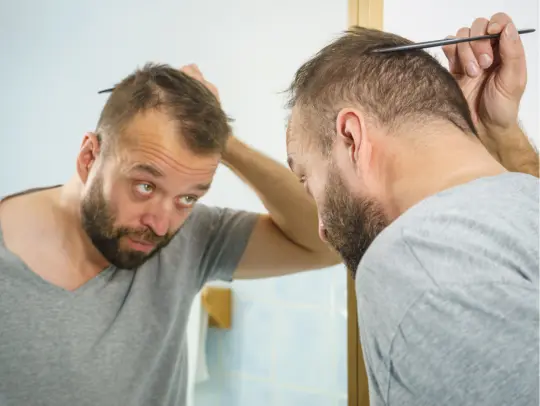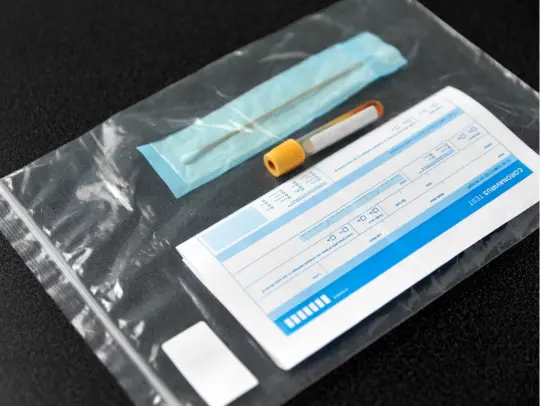
Nurse Practitioner Clarissa - Help! My Hair Is Falling Out: A No-BS Guide to Growing It Back
Help! My Hair Is Falling Out: A No-BS Guide to Growing It Back
Let's talk about something that affects way more women than you might think: hair loss. If you're noticing more hair in your brush lately or your ponytail is getting thinner, you're definitely not alone. This guide cuts through the marketing hype to give you the real deal on what actually works for regrowing your hair, why it's falling out in the first place, and how to get your gorgeous locks back.
The Reality Check: At least 1 in 3 women will deal with hair loss or thinning at some point in their life. More than 20 million women in the US have androgenetic alopecia (that's the fancy name for female pattern hair loss). By age 50, about 40% of women have noticeable hair loss. You're definitely not alone in this!
What Female Hair Loss Actually Looks Like
Women's hair loss looks different from men's. Instead of that receding hairline guys get, women usually notice:
- Thinning at the part line that gradually widens
- Overall loss of volume at the crown (top) of your head
- Being able to see more of your scalp than before
- Hair that breaks more easily and feels finer
- Increased shedding (more than the normal 50-100 hairs a day)
While guys tend to go bald from front to back, we typically thin out from our part line toward the top of the scalp, often in a Christmas-tree pattern. And unlike men, women usually keep their frontal hairline intact (small silver lining?).
Why Is Your Hair Jumping Ship?
There are so many reasons your hair might be thinning, and figuring out the cause is key to finding the right solution. Here are the usual suspects:
Genetics and Hormones
Thanks, Mom and Dad! Female pattern hair loss is often genetic and usually kicks in after 40, though it can start earlier. Your hormones play a huge role too, which is why many women notice hair changes during these times:
- After having a baby: That postpartum shed is REAL. About 2-6 weeks after giving birth, many new moms watch in horror as hair comes out in clumps. This happens because your hormones are crashing back to normal after pregnancy.
- During/after menopause: As estrogen drops, hair often thins out.
- When stopping birth control: Similar hormone roller coaster, similar hair drama.
Medical Conditions
Your hair can be like a check engine light for your body. These health issues often show up as hair loss:
- Thyroid problems (both overactive and underactive)
- Anemia or low iron levels
- Autoimmune conditions like alopecia areata (which causes round, bald patches)
- Scalp infections like ringworm
- PCOS (Polycystic Ovary Syndrome)
- Diabetes
Stress and Trauma
Ever heard someone say they were so stressed their hair fell out? That's actually a real thing called telogen effluvium. Major physical or emotional stress can shock your hair follicles into their shedding phase all at once. This can happen after:
- Major weight loss
- Surgery or illness
- Grief or loss
- High fever
- Extreme stress at work or home
Lifestyle Factors
Sometimes we're unintentionally sabotaging our own hair health:
- Diet: Crash dieting or not getting enough nutrients can lead to major shedding.
- Hair styling: Tight ponytails, braids, or extensions can cause traction alopecia.
- Heat damage: Constant flat ironing, blow drying, or bleaching can weaken hair.
- Medications: Blood thinners, some antidepressants, and certain other drugs list hair loss as a side effect.
Treatments That Actually Work
Enough about the problems—let's talk solutions! Here are treatments that have real science behind them:
Minoxidil: The Only FDA-Approved Option
The star player in the hair regrowth game is minoxidil (you might know it as Rogaine). It's currently the only FDA-approved treatment for female pattern hair loss, and it does work for many women.
The Details:
- For women: Use the 2% solution or 5% foam (available over the counter)
- Success rate: About 1 in 4 women see significant regrowth
- With the foam version, up to 81% of women notice improvement
- Takes patience—expect to wait 6-12 months to see results
- You have to keep using it forever, or the new growth will disappear
Watch out for side effects like:
- Scalp irritation, redness, or itching
- Unwanted hair growth in other places (like your forehead or cheeks)
- If these happen, talk to your doctor about switching to a lower percentage or try using it less frequently
Newer Options on the Scene
Science has been busy developing more ways to fight hair loss:
- Laser therapy: Those futuristic-looking laser combs and helmets? They're FDA-cleared and use low-level light to stimulate hair follicles. About 75% of users see some improvement.
- Platelet-Rich Plasma (PRP): This treatment takes your own blood, spins it down to concentrate the growth factors, then injects it back into your scalp. Sounds vampire-ish, but around 75% of women get good results.
- Hair transplants: More women are opting for this permanent solution. A surgeon takes hair from the back of your scalp (where it's typically thicker) and moves it to thinning areas. It's pricey but effective.
Supplements That Support Hair Growth
Giving your body the right building blocks can make a big difference for hair growth. The PeakBody Hair Growth Support for Women mentioned in the video is specifically formulated with ingredients shown to help with female hair regrowth:
- Biotin: This B vitamin is essential for healthy hair and may help strengthen brittle strands
- Silica: Helps improve hair strength and shine
- Collagen: Provides the amino acids needed to build hair proteins
- Iron, folic acid, and omega-3 fatty acids: All crucial nutrients for hair growth
The recommended dosage is two tablets daily with meals. The supplement is non-GMO, GMP certified, and contains no fillers. You can find PeakBody supplements on their official website or through select retailers.
For best results, combine supplements with the other hair-friendly strategies mentioned in this article. Give any supplement at least 3-4 months to start showing results—hair grows slowly, so patience is key!

Hair Growth for Women
Womens Hair Growth Treatment
Womens Hair Growth Treatment Natural SupplementsRegular Price $49.00
Your Price Buy Now!
Coupon automatically added to your cart
Hair-Friendly Habits That Make a Difference
Beyond treatments and supplements, these everyday habits can help keep the hair you have and support new growth:
Styling Smarter
- Ditch tight hairstyles that pull on your scalp
- Take breaks from heat styling tools
- Skip harsh chemical treatments when possible
- Be gentle with wet hair—use a wide-tooth comb, not a brush
- Try a silk pillowcase to reduce friction and breakage
Feeding Your Follicles
- Eat protein-rich foods (your hair is made of protein!)
- Include healthy fats like avocados and olive oil
- Don't crash diet—gradual weight loss is better for your hair
- Stay hydrated—dehydration can make hair brittle
Stress Management
- Find stress-busting activities that work for you
- Prioritize sleep—it's when your body repairs itself
- Exercise regularly to boost circulation to your scalp
When to See a Doctor
While some hair thinning is normal as we age, certain symptoms suggest something more serious might be going on. Schedule a doctor's appointment if:
- Your hair loss is sudden or severe
- You notice bald patches instead of overall thinning
- You also have scalp pain, itching, redness, or scaling
- You're experiencing other symptoms like fatigue or unexplained weight changes
- Hair loss treatments aren't working after several months
Your doctor might do blood tests to check for underlying conditions, examine your scalp, or perform a "pull test" to check hair strength. They might also do a small scalp biopsy if they suspect certain conditions.
If your regular doctor isn't finding answers, ask for a referral to a dermatologist who specializes in hair loss or to an endocrinologist if hormonal issues are suspected.
The Bottom Line on Female Hair Regrowth
Hair loss can be emotionally tough, but remember—you've got options. Between minoxidil, supplements like PeakBody's formula, and newer treatments like PRP and laser therapy, there are more ways than ever to fight thinning hair.
The key is being proactive, patient, and persistent. Hair grows at about half an inch per month, so give any treatment at least 3-6 months before judging results. And while you're waiting for regrowth, there's absolutely no shame in exploring wigs, topical hair fibers, or creative styling to help you feel your best.
Remember that you're definitely not alone in this journey—millions of women are dealing with the exact same issue, even if they're not talking about it. With the right approach, most women can see improvement in their hair's thickness and health. Here's to your hair growth success!
























































